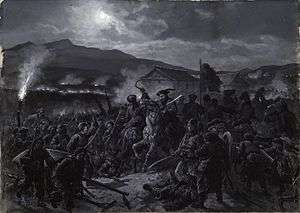Battle of Pyongyang (1894)
| Battle of Pyongyang | |||||||
|---|---|---|---|---|---|---|---|
| Part of the First Sino-Japanese War | |||||||
 Battle of Ping Yang: The routing of the Chinese Army | |||||||
| |||||||
| Belligerents | |||||||
|
|
| ||||||
| Commanders and leaders | |||||||
|
Yamagata Aritomo (overall command) Nozu Michitsura (5th Division) Katsura Taro (3rd Division) |
Ye Zhichao General Zuo Baogui † | ||||||
| Strength | |||||||
| 20,000 | 13,000 – 15,000 | ||||||
| Casualties and losses | |||||||
|
102 killed 433 wounded 33 missing |
2,000 killed 4,000 wounded | ||||||
The Battle of Pyongyang (Japanese: 平壌作戦) was the second major land battle of the First Sino-Japanese War. It took place on 15 September 1894 in Pyongyang, Korea between the forces of Meiji Japan and Qing China. It is sometimes referred to archaically in western sources as the “Battle of Ping-yang”. Between 13,000 and 15,000 Chinese troops of the Beiyang Army had arrived in Pyongyang on 4 August 1894, and had made extensive repairs to its ancient city walls, feeling itself secure in its superior numbers and in the strength of the defenses.
Battle
The 10,000 troops (not confirmed) of the Imperial Japanese Army's 1st Army Corp, under the overall command of Marshal Yamagata Aritomo consisted of the 5th Provincial Division (Hiroshima) under Lieutenant General Nozu Michitsura, and the 3rd Provincial Division (Nagoya) under Lieutenant General Katsura Taro. Japanese forces had landed at Chemulpo (modern Inchon, Korea) on 12 June 1894 without opposition. After a brief sortie south for the Battle of Seonghwan on 29 July 1894, the First Army marched north towards Pyongyang, rendezvousing with reinforcements, which had landed via the ports of Busan and Wonsan.
The Japanese Army First Army converged on Pyongyang from several directions on 15 September 1894, and in the morning made a direct attack on the north and southeast corners of the walled city under very little cover. The Chinese defense was strong, but was eventually outmaneuvered by an unexpected flanking attack by the Japanese from the rear, costing the Chinese very heavy losses compared to the Japanese. At 16:30, the garrison raised the white flag for surrender. The fall of the city, however, was delayed due to a heavy rainfall. Taking advantage of the delay and the fall of darkness, the survivors of the Chinese garrison escaped the city for the coast and the border town of Wiju (modern village of Uiju, North Korea) on the lower reaches of the Yalu River) by 20:00 hours.
Chinese casualties are estimated at 2000 killed, and around 4000 wounded. The Japanese lost 102 men killed, 433 wounded and 33 missing.
Qing Muslim General Zuo Baogui (左寶貴) (1837–1894), from Shandong province, died in action in Pyongyang, from Japanese artillery. A memorial to him was constructed.[1] Before the battle Zuo Baogui performed ablution (Wudu or Ghusl) according to Islamic custom.[2][3][4][5]
Pyongyang fell to Japanese forces by the early morning of 16 September 1894.
Aftermath
After the Battle of Pyongyang, command of Japanese First Army was turned over from Marshal Yamagata to General Nozu for reasons of health. Nozu's former command of the 5th division was assumed by Lieutenant General Yasukata Oku. After the Battle of Pyongyang, the Japanese advanced north to the Yalu River without opposition. The Chinese had decided (as would the Russians ten years later in the Russo-Japanese War) to abandon northern Korea and defend from the northern bank of the Yalu River.
References
- ↑ Aliya Ma Lynn (2007). Muslims in China. Volume 3 of Asian Studies. University Press. p. 44. ISBN 0-88093-861-7. Retrieved 2010-06-28.
- ↑ http://www.muslem.net.cn/bbs/article-14126-1.html
- ↑ http://www.muslem.net.cn/bbs/article-12642-1.html
- ↑ http://www.muslem.net.cn/bbs/article-14357-1.html
- ↑ http://www.muslem.net.cn/bbs/portal.php?mod=view&aid=14126
- Chamberlin, William Henry. Japan Over Asia, 1937, Little, Brown, and Company, Boston, 395 pp.
- Kodansha Japan An Illustrated Encyclopedia, 1993, Kodansha Press, Tokyo ISBN 4-06-205938-X
- Lone, Stewart. Japan's First Modern War: Army and Society in the Conflict with China, 1894-1895, 1994, St. Martin's Press, New York, 222 pp.
- Paine, S.C.M. The Sino-Japanese War of 1894-1895: Perception, Power, and Primacy, 2003, Cambridge University Press, Cambridge, MA, 412 pp.
- Warner, Dennis and Peggy. The Tide At Sunrise, 1974, Charterhouse, New York, 659 pp.
Coordinates: 39°02′N 125°45′E / 39.033°N 125.750°E